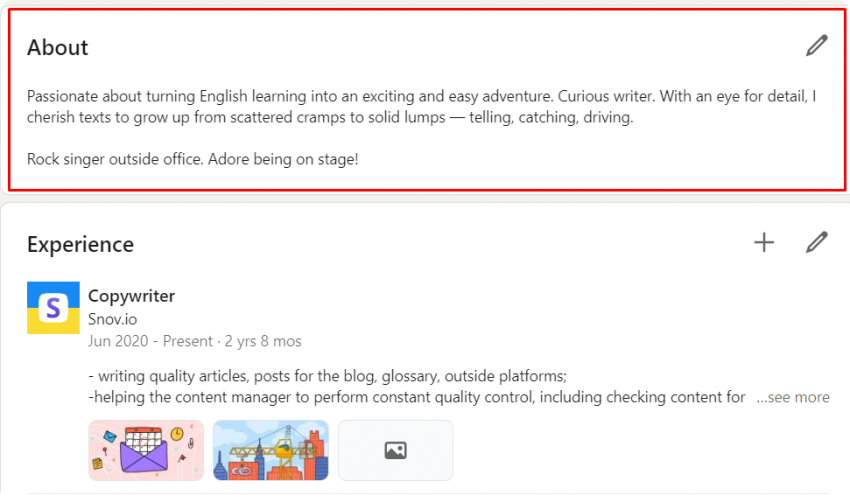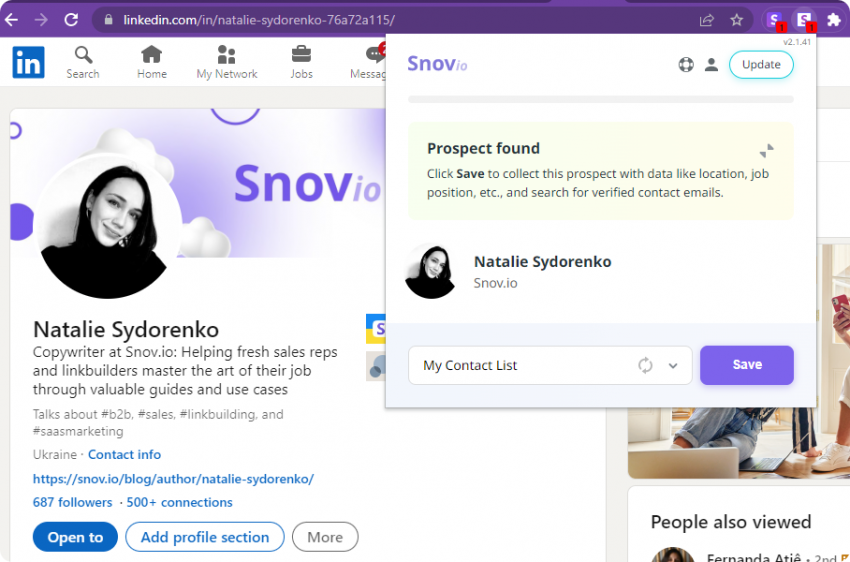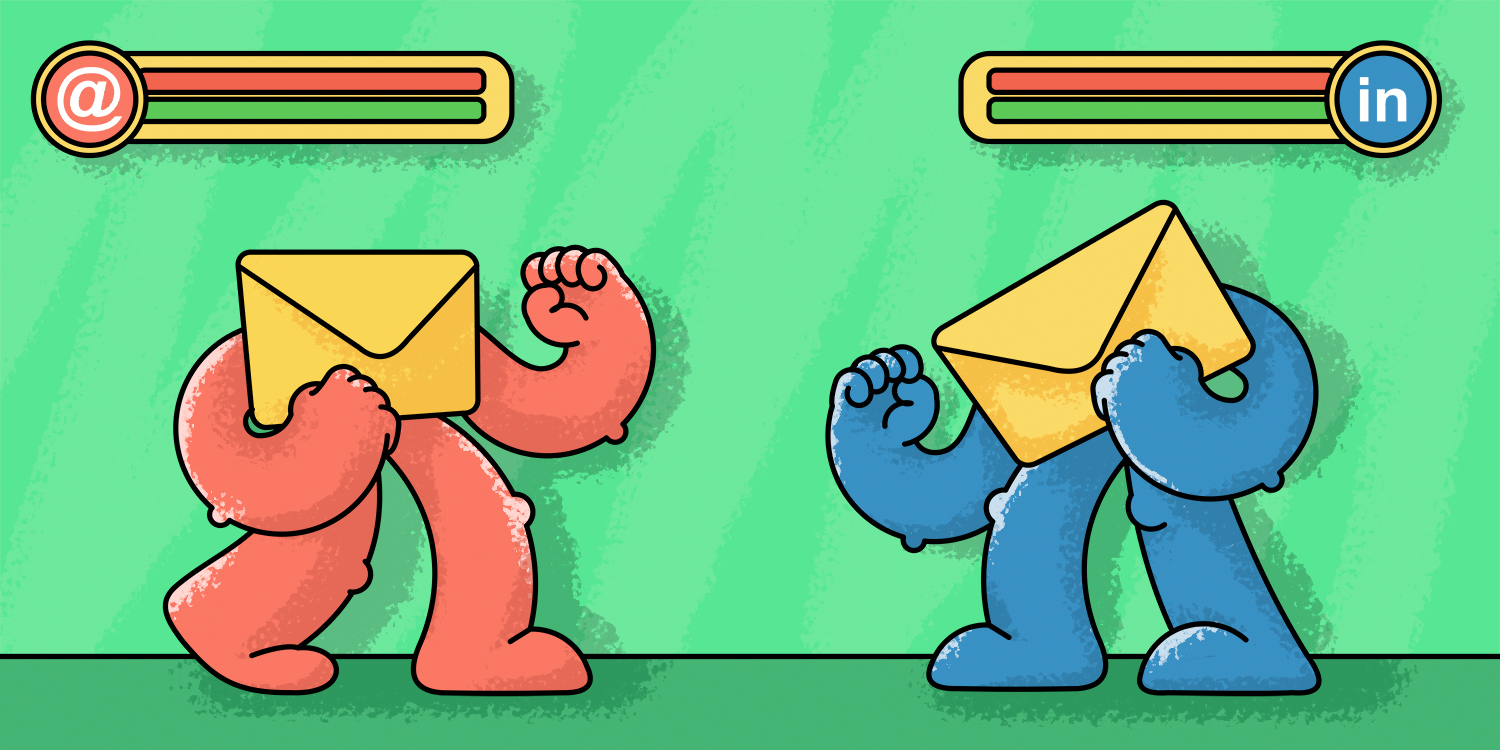Using social media for sales isn’t a question any longer – pandemic reality favored social selling better than ever before. Now the question is rather which social network works best. For those companies operating in B2B, the answer is evident: no platform can compare to LinkedIn, which hubs about 80% of social leads.
If you still can’t call yourself a LinkedIn social selling guru, no worries – in this guide, you’ll learn the nuances that will help you sell on LinkedIn like a pro.
Outline:
What is social selling on LinkedIn?
Let’s start with the social selling definition first.
Social selling is using social media channels to connect and build relationships with prospects that would further result in sales. Thus, social selling on LinkedIn presupposes that you’ll use LinkedIn to develop connections with your prospects, who you’ll transform into paying customers.
To better understand how well your position as a LinkedIn social seller is, you can regularly check your Social Selling Index (SSI) score. By rating your LinkedIn performance based on four categories, this tool reveals what social selling actually depends on, namely, how well you’re:
- Establishing your professional brand
- Finding the right people
- Engaging with insights
- Building relationships

The score you see above is the one you should strive for, but sadly, not all sales reps can boast of such a result. Let’s find out why.
Common LinkedIn sales mistakes you’d better avoid
When you only start your LinkedIn social selling journey, you risk making 7 typical mistakes that prevent you from using this powerful platform effectively, hence growing your SSI:
#1. Not elaborating on your profile
It’s not enough just to create your LinkedIn profile. You need to ensure it’s always up-to-date and looking top-notch.
In practice, many sales reps have a profile that doesn’t go in line with their value proposition. They highlight what a great person they are or how much they’ve achieved, forgetting that their main goal is not to find a job – they’re on LinkedIn to build relationships that would drive sales.
#2. Not growing your network
About 80% of sales professionals say networking is the most effective way of lead generation on LinkedIn. Yet, not many spend time (regularly!) establishing a network of contacts. If you prefer joining those lazy ones, prepare yourself for oblivion and a stale customer base.
#3. Not doing the research before connecting with prospects
A common misconception is that prospecting on LinkedIn boils down to simply finding prospects.
No, and no…
Prospecting is about both search and research. Prospect research is what sales professionals usually call ‘doing your homework.’ In other words, you need to gather as much information about your prospects as possible to further build rapport and personalize your sales pitch.
And while it may seem difficult, in most cases, visiting a prospect’s LinkedIn profile is enough to draw a picture of what they are, what they like, and…what they really need.
#4. Sending connection requests to everybody
If you don’t have much experience with LinkedIn social selling, you might be tempted to start sending connection requests to as many people as possible to grow your network quickly. This way, you risk being banned by LinkedIn algorithms and losing your image.
|
Note: Remember that LinkedIn reduces the number of connections you can send to 100 a week. |
If you have questions about how LinkedIn limits work and how to avoid being blocked, read our recent post.
#5. Not providing a reason to connect
From time to time, I get connection requests from strangers without understanding the reason these LinkedIn users are knocking on my door. And if you’re doing it the same way, you’d better stop it. That’s a sure explanation for why people might decline your connection requests. You need to clarify why you’re asking someone to connect with you.
#6. Not personalizing your messages
People adore feeling special. And they really don’t care how many LinkedIn users you’re reaching out to at the moment. If they feel like you’re communicating with them based on a single template, your LinkedIn social selling strategy may be crashed. You need to think about how to personalize your communication, especially if you’re messaging prospects in bulk.
#7. Not providing value to your connections
LinkedIn users may accept your connection requests, but if they get no value from it, they’ll still perceive you as a stranger or, even worse, delete you after a while. This is a common outcome if sales reps post too many ads or self-promotional content. Don’t be among them.
Okay…Learning from mistakes is a good rule to follow, but we are here to find the solutions, aren’t we?
The next chapter will help you build your LinkedIn social selling strategy stage by stage, providing solutions to all the mistakes mentioned above.
6 steps to social selling on LinkedIn
Step 1. Establishing a personal brand on LinkedIn
Social media is where your name plays a pivotal role. You may have a great product to sell, but if your LinkedIn persona is not prominent, you’ll have trouble finding customers on social networks. Hence, your first step must be to build your brand on LinkedIn by optimizing your LinkedIn profile for sales and making it customer-centric.
Here’s how to optimize your LinkedIn profile for sales:
LinkedIn profile picture
Your LinkedIn profile picture is more important than you may think – LinkedIn research shows that just having a picture makes your profile 14 times more likely to be viewed by others.
Yet it’s not enough just to upload any photo of yourself. LinkedIn is a professional network, so must be your picture.
Ensure you’re using a headshot of good quality that highlights your role. No other people displayed, no weird background. Just you looking professional and friendly.
LinkedIn background photo
Not many people really care about it… Yet they should! Your background photo can profitably advertise your company or express what you are ready to do as a sales rep to make customers happy.

LinkedIn headline
This is what people will see under your name. Ensure you don’t just state your job position there, but add some value. Personally, I like the formula for LinkedIn headline Hubspot provides:
[Title]: Helping [prospects] do X
For example, if you are a software sales manager, your LinkedIn headline can be the following:
“Sales Manager: Helping digital marketers automate their marketing campaigns”
LinkedIn summary
The LinkedIn summary, also known as the LinkedIn bio or LinkedIn About section, is a few paragraphs of text that appear right before a user’s list of current and prior roles.
That’s how I made it in my profile:

Ensure your LinkedIn summary is at most two paragraphs long. Describe what makes you passionate about the job and your unique value proposition. Don’t make your summary too formal – your prospects will better perceive it if you show you’re a human being just like them.
LinkedIn role descriptions
In the ‘Experience’ section, Linkedin users commonly describe where they work and what their role in the company is/was. While displaying your current position, again, focus on the value rather than general phrases like ‘sell B2B solutions.’
Make your profile more targeted so your leads understand you are the one who can help specifically their business. Here are some examples of what you can say:
- Work with companies in the X industry to help them boost their marketing performance.
- Help customers improve their revenue by 20% annually.
- Provide solutions to lead generation problems to companies working in the X industry.
Recommendations
LinkedIn recommendations give you social proof and help prospective customers understand you are an expert worth relying on. Moreover, they can be sure the testimonials you’ve got are not fake – by simply clicking the profiles of people who have left recommendations on your LinkedIn profile.
The more recommendations you get, the better. The way to ask them is not as complicated as it may seem – you just need to do a bit of feedback management. Each time you get positive feedback in your email or InMail, thank a person and ask them politely if they can restate their high appraisal in the form of a recommendation on your LinkedIn profile.

Step 2. Building relationships on LinkedIn
Now that your profile looks appealing, it’s high time to establish a LinkedIn network.
Connect with colleagues and other professionals you know
Start by connecting with people you know. This is a sure way to expand your network without the risk of being blocked by LinkedIn algorithms, as people who are acquainted with you will most likely accept your invitation to connect.
Connect with your customers on LinkedIn
Already have customers who are still not in your LinkedIn network? Correct this misunderstanding. Connect with as many of them as possible; these people can recommend you and help you establish your personal brand.
Connect with 2nd and 3rd-level connections
People who have accepted your connection request or whose connection request you’ve accepted become your 1st-level connection. Now that you’ve got the list of these connections, it’s time to connect with the people they’re connected with – so-called 2nd and 3rd-level connections. That’s where the ‘Friend of my friend is my friend’ scenario is likely to work, so you’ll expand your network on LinkedIn even more.
|
Note: It’s advisable to connect with people related to your industry, job position, and product. First, there will be more chances that your connection request will be accepted. Second, you’ll increase your opportunities to connect with potential customers. |
Connect with people using LinkedIn’s Advanced search mechanism
Go further and find more professionals to join your network of connections on LinkedIn. Using the LinkedIn Advanced search function, you can filter users and find LinkedIn profiles related to your product that can become your partners or prospects.
|
Keep in mind: Get used to looking through your connection invitations once per two weeks and withdraw those connections who have not accepted your invitation during a 2-week period. |
Follow influencers
Big sharks in your industry whom you follow can help you increase your social selling capacity as you’ll use their ideas for your content on LinkedIn – an inevitable aspect of growing authority on LinkedIn.
And this will be your next step to social selling on LinkedIn.
Step 3. Growing authority through content
I won’t say much about how important it is to write customer-focused content. Just consider the numbers:
- About 90% of customers find custom content useful.
- 80% of customers appreciate learning about a company through custom content.
- 78% of customers perceive a relationship between themselves and a company using custom content.
- 70% of customers feel closer to a company after reading its content.
Here are several tips on how to post on LinkedIn and grow your authority via content marketing:
Provide valuable content for your target audience
Think back to your ideal customer profile, their needs, and pain points which you may solve. Create LinkedIn posts that discuss customer and prospects’ problems and provide solutions.
Alternatively, you can repost relevant blog articles or articles from LinkedIn Publisher if you use this platform to post your content.
Curate popular content relevant to your prospects
Content curation presupposes sharing content created by others that would be valuable to your prospects. This must be the additional strategy to publishing your own original pieces.
It will work well if you share some content from top gurus you’re following on LinkedIn, especially if you add your perspective or provide your sum-ups to it, so your prospects could get quick solutions to their current challenges.
Stay top of mind through regular posting and commenting
It’s not enough to just write a post on LinkedIn and forget about it. To grow authority, your content marketing strategy should be consistent, so schedule how often you’ll post or share posts.
Remember to comment on others’ posts. Join LinkedIn groups where people discuss troubles typical of your prospects. Participate in discussions actively by commenting on the questions raised or topics discussed. It’s a sure way to demonstrate your expertise and draw the public’s attention to your profile and product.
Encourage engagement with your posts
Your postings on LinkedIn may have a few impressions in the beginning. It’s okay. Encourage your colleagues and people you know who are present on LinkedIn to react to them. Alternatively, you can use automation tools such as Podawaa that would help you increase your LinkedIn post’s reach.
Step 4. Prospecting on LinkedIn: search and research
How to find prospects on LinkedIn
You’ve approached one of the most critical stages of social selling – prospecting. LinkedIn offers an array of possibilities when it comes to finding prospects.
Here I’ll sketch the best options for how you can find prospects on LinkedIn:
- Go through your connections to find people who match your ideal customer profile.
- Join LinkedIn groups and actively participate in discussions to demonstrate your expertise and provide value.
- Use search alerts to reach out to new decision-making positions and get weekly notifications once LinkedIn finds people that match your search criteria.
- Use Alumni search to find people with whom you have something in common.
- Investigate competitor’s networks to find more about their prospects whom you can further poach owing to your expertise and the value of your solution.
- Look through the “People also viewed” section to find people similar to your contacts.
- View the Skills & Endorsements of your customers to find people who may become your potential customers.
- Look through Posts & Activity in your LinkedIn account to see who has interacted with your posts – they may become your prospects.
- Browse people who have interacted with your prospects’ and customers’ posts.
- Run Boolean Search for more advanced filtering to find exactly what you are looking for.
- Use LinkedIn Sales Navigator for more advanced filters (just keep in mind that this tool is not free).
Get more information on LinkedIn prospecting techniques, methods, and use cases by reading our post.
How to do prospect research on LinkedIn
Now it’s time to learn about your prospects better. Let’s find out how to research on LinkedIn to make your social selling strategy successful:
- View the ‘Highlights’ section
The ‘Highlights’ section in a prospect’s LinkedIn profile shows any insights between your profile and your prospect’s profile, for example, shared connections, experiences, education, job postings, etc.

You can use this information as a hook while connecting with the prospect or while reaching out to them via email/InMail.
- Look through the ‘Featured’ section
The ‘Featured’ section shows your prospect’s content in chronological order. You can see what posts a prospect has authored or re-shared, articles they’ve published on LinkedIn, and even external media like links and documents. This will help you understand 1) what content they are proud of and focus on it in your outreach message or 2) what content they are interested in so you can offer them something similar.

- Scan the ‘Activity’ section
This section showcases your prospect’s professional interests. You can see what they comment on, share, celebrate, and get a better grasp of the problems they try to resolve. What is more, you can better understand your prospect’s psychology and analyze the tone they use while communicating.

- Go through the ‘Interests’ section
At last, you must learn what personas, groups, or products your prospects are interested in. This can unveil their role models and business philosophy and give you a hint of what values they have and what trends they follow.

Step 5. Connecting and interacting with prospects
Send the prospect a personalized connection request message
Although this step follows the ‘Prospecting’ stage here in the guide, in practice, you’ll get it like this: you find a prospect, view any information in their profile that you can use as a hook for conversation, and send the personalized connection request.
On LinkedIn, you’d better do it by adding a personalized note to your invitation:

Don’t make your connection invitation note very long and detailed. As you see, LinkedIn restricts this message up to 300 characters.
Keep interaction going
Sending one connection request message is not enough to build meaningful relationships with a prospect. Now that your connection request has been accepted go on engaging with your prospect’s posts, appear as an expert in mutual groups, and/or send them professional content that would help overcome one of their key pain points.
|
Important: Don’t try to sell or even show a sign of a sales pitch at any of the above steps. Social selling is about building relationships, not selling. |
Step 6. Moving the conversation outside LinkedIn
Now that you’ve established a connection with a prospect, it’s time to move the conversation outside LinkedIn to learn more about the prospect’s issues and offer help via your solution.
The best way to break the ice is to send your prospects a cold outreach message, slowly and non-intrusively leading them to discover your product.
If you’re planning to write a cold outreach message to a single prospect, there are three options you may try:
- sending them a LinkedIn message;
- sending them an InMail;
- connecting with them via email.
Yet, if you’re going to reach out to prospects in bulk, you won’t be able to do it via LinkedIn message. So you’ll have to choose either an InMail or email.
How to reach out to the LinkedIn prospect via email
Reaching out to prospects via email allows you to contact them in bulk, do it for free, and avoid LinkedIn restrictions. All you have to do is to get your LinkedIn prospects’ email addresses.
Here you can go two ways:
- ask them for their email address directly
- use an email finder tool to automatically extract an email address
For example, with Snov.io Li Prospect Finder, getting an email address from a prospect’s LinkedIn profile will be a minute job. You just need to download an extension, enable it (by clicking the icon in your extensions bar) while you’re on a prospect’s LinkedIn profile page, and save the email to your list:

You can also use this extension for finding mass emails on LinkedIn search result pages or company LinkedIn profiles.
How to write a cold message to LinkedIn prospects
While composing your cold outreach message to LinkedIn prospects, remember that it should be direct, personalized, and tempt a prospect to call or meet with you. Consider a template I’ve created with the Snov.io Email Drip Campaigns tool:

As you see, the tool allows using personalization variables, which will automatically insert the data of prospects, allowing you to send a cold message to LinkedIn prospects in bulk and not worry about personalization.

Don’t forget to follow up with the prospect if you get no response to your initial message. Remember, you deal with busy people for whose attention you need to fight. So don’t give up:)
Wrapping up
Social selling on LinkedIn requires time, energy, and patience. In this guide, you’ve learned how to make the process go smoother by breaking it down into stages as well as how to avoid typical LinkedIn sales mistakes that prevent you from growing professionally.
Now it’s your turn to probe all these tips and enrich them with your experience and practical skills. And if any stage of your LinkedIn social selling strategy wants automation, Snov.io tools are at your disposal.





